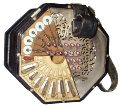




Glitches, Gremlins, Concertina Spooks; loose pads, sticking buttons, broken springs, notes not sounding; odd button effects; fault finding; broken straps; sheared end bolts, the list goes on and on. Concertinas are a mixture of Victorian engineering, book binding leatherwork, cabinet making; and very elementary physics. Things do and will go wrong, consult the Concertina Maintenance Manual or make contact here, I will guide or assist.
The concertina is jam packed full of little bits and pieces, felt bushes, springs, reeds, pads, valves etc. All of which have a useful life after which instrument performance starts to decline. Servicing is the planned replacement of consumable items, worn and damaged components, plus adjustments needed to ensure that a good playing instrument is kept at its peak, BEFORE real problems are experienced. Typically pads, valves, springs, bushing etc and some low level tuning adjustments, the repair or binding of bellows. This is relatively low cost work, and a typical service interval is around 10 years, subject to how much it is played, and overall general condition
When instruments first emerge from 60 yrs of hibernation in an attic, back of wardrobe, or where ever, It is almost guaranteed that it will need a lot more than a general service, it will need all the service elements above, plus possibly new bellows, straps, broken fretwork attending to; the tuning will be in the old pitch before the international standard of Concert Pitch was established (A= 440hz). Reeds may be corroded, some may be broken, they will need an extensive clean, as will the whole of the instrument. There will be moth and insect damage. It is essential that the instrument is assessed by someone with competence, its the difference between a restoration job, or a retirement project, or worse.
Some Instruments are just beyond economical repair, they move from restoration to labours of love. If your instrument is in that category, then you will be advised accordingly. Equally if there is a risk a repair will not work out, you will advised accordingly.
I hate to see instruments scrapped off for parts, some times I do buy them for parts, some time I buy them as retirement projects, looking at my shelves, I have to hope for a long retirement.





